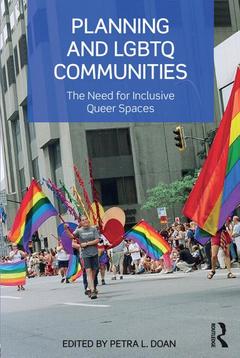Planning and LGBTQ Communities The Need for Inclusive Queer Spaces
Coordonnateur : Doan Petra L.

Although the last decade has seen steady progress towards wider acceptance of lesbian, gay, bisexual, transgendered, and queer (LGBTQ) individuals, LGBTQ residential and commercial areas have come under increasing pressure from gentrification and redevelopment initiatives. As a result many of these neighborhoods are losing their special character as safe havens for sexual and gender minorities. Urban planners and municipal officials have sometimes ignored the transformation of these neighborhoods and at other times been complicit in these changes.
Planning and LGBTQ Communities brings together experienced planners, administrators, and researchers in the fields of planning and geography to reflect on the evolution of urban neighborhoods in which LGBTQ populations live, work, and play. The authors examine a variety of LGBTQ residential and commercial areas to highlight policy and planning links to the development of these neighborhoods. Each chapter explores a particular urban context and asks how the field of planning has enabled, facilitated, and/or neglected the specialized and diverse needs of the LGBTQ population.
A central theme of this book is that urban planners need to think "beyond queer space" because LGBTQ populations are more diverse and dispersed than the white gay male populations that created many of the most visible gayborhoods. The authors provide practical guidance for cities and citizens seeking to strengthen neighborhoods that have an explicit LGBTQ focus as well as other areas that are LGBTQ-friendly. They also encourage broader awareness of the needs of this marginalized population and the need to establish more formal linkages between municipal government and a range of LGBTQ groups. Planning and LGBTQ Communities also adds useful material for graduate level courses in planning theory, urban and regional theory, planning for multicultural cities, urban geography, and geographies of gender and sexuality.
Chapter 1 –Why Plan for the LGBTQ Community? PART ONE PLANNING AND LGBTQ POPULATIONS IN TRADITIONAL GAY NEIGHBORHOODS Chapter 2 -Gay Commercial Districts in Chicago and the Role of Planning Chapter 3 -The Dallas Way: Property, Politics, and Assimilation Chapter 4 -Fractures and Fissures in "Post-Mo" Washington, DC: The Limits of Gayborhood Transition and Diffusion PART TWO: PLANNING AND LGBTQ POPULATIONS OUTSIDE THE GAY VILLAGE Chapter 5 -Thinking Beyond Exclusionary Gay Male Spatial Frames in the Developing World Chapter 6 -The Pervasiveness of Hetero-Sexism and the Experiences of Queers in Everyday Space: The Case of Cambridge, Massachusetts Chapter 7 -Identifying and Supporting LGBTQ Friendly Neighborhoods in the American South: The Trade-off Between Visibility and Acceptance PART THREE: EXPANDING PLANNING HORIZONS: RECOGNIZING LGBTQ INTERSECTIONALITY Chapter 8 -Finding Transformative Planning Practice in the Spaces of Intersectionality Chapter 9 -Southern Discomfort: In Search of the LGBT-Friendly City Chapter 10 -The Queer Cosmopolis: The Evolution of Jackson Heights Chapter 11 -Lesbian Spaces in Transition: Insights from Toronto and Sydney PART FOUR: LINKING PLANNING AND LGBTQ ACTIVIST GROUPS TO ENSURE SERVICE DELIVERY Chapter 12 -Act Up versus Straighten Up: Public Policy and Queer Community-Based Activism Chapter 13 -Place / Out: Planning for Radical Queer Activism Chapter 14 -The Racial Politics of Precarity: Understanding Ethno-specific AIDS Service Organizations in Neoliberal Times Chapter 15 -Beyond Queer Space: Planning for Diverse and Dispersed LGBTQ Populations
Petra L. Doan is Professor of Urban and Regional Planning at the Florida State University. She has published numerous articles and chapters on queer planning issues, including several path-breaking articles on transgender experiences of gendered urban spaces. Her edited book Queerying Planning: Challenging Heteronormative Assumptions and Reframing Planning Practice was published by Ashgate in 2011.
Date de parution : 03-2015
15.6x23.4 cm
Date de parution : 03-2015
15.6x23.4 cm
Thèmes de Planning and LGBTQ Communities :
Mots-clés :
Single Member Districts; Queer planning; LGBTQ Respondent; LGBTQ planning; Mainstream LGBT Community; LGBTQ spaces; De La Croix; Inclusive planning; LGBTQ Space; gayborhood; Christopher Street Pier; Gay village; LGBTQ Neighborhood; Curt Winkle; LGBTQ Youth; Andrew H; Whittemore; Gay Villages; Nathaniel M; Lewis; LGBTQ Population; Gustav Visser; LGBTQ Immigrant; Sarah P; Nusser; LGBTQ People; Katrin B; Anacker; LGBTQ Community; Michael Frisch; LGBTQ Individual; Joan Marshall Wesley; Inclusive Queer Spaces; Arianna Martinez; LGBT Neighborhood; Catherine J; Nash; Queer Spaces; Andrew Gorman-Murray; Gay Commercial Districts; Gail Dubrow; LGBTQ Resident; Larry Knopp; Traditional Gay Villages; Michael Brown; LGBT Community; Kian Goh; Gay Commercial; John Paul Catungal; Queer Urban Spaces; LGBT People; Jackson Heights
